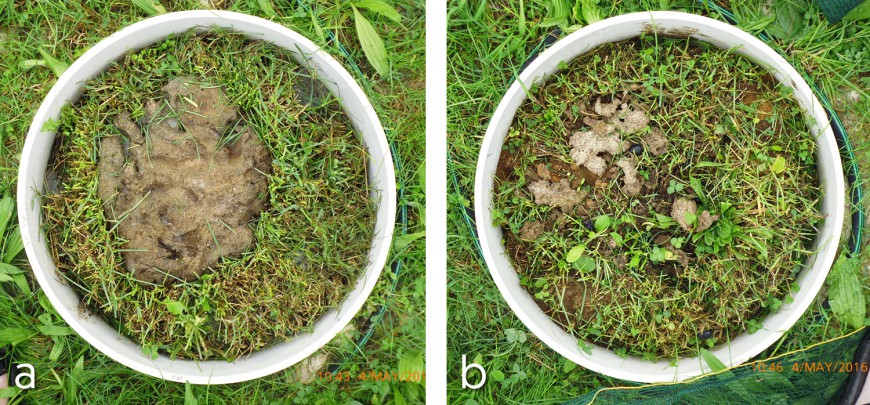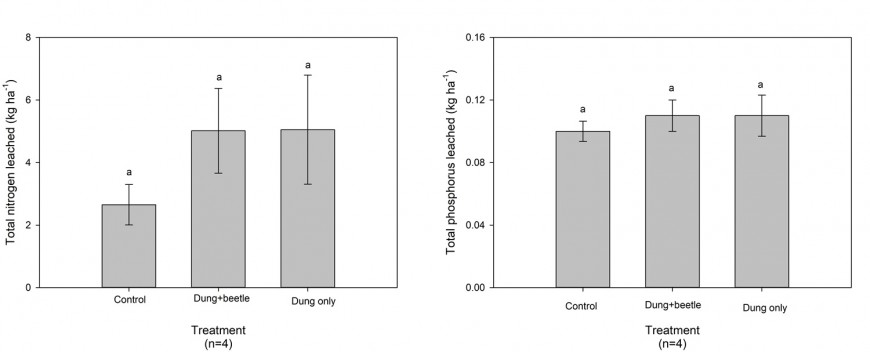Dung beetles: NZ’s missing link to achieve sustainable pastoral agriculture?

Figure 1. Dung pat 22 days after application without (a) and with dung beetles (b).
As indigenous dung beetles that process mammalian dung do not occur in NZ they have been introduced (Dung Beetle Innovations). More needs to be known about the net impact of introduced dung beetles on the transport of contaminants through different soil orders.
We investigated whether tunnelling dung beetle activity, with resultant changes to soil structure, impacted leaching of microbial pathogens and nutrients in Allophanic Soil. A leaching experiment using 12 intact soil core lysimeters under in situ soil moisture and temperature regimes was conducted. Four lysimeters received dung and beetles (Geotrupes spiniger and Onthophagus taurus), 4 received dung and no beetles, and 4 (controls) received no dung and no beetles (Fig. 1). The quality of water leaching through the soil was assessed by monitoring leachate samples for Escherichia coli, commonly known as E. coli, an indicator of microbial pathogens derived from faecal material, and the nutrients nitrogen, phosphorus. The experiment was carried out from April to October 2016 using an Allophanic Soil from Waikato, representative of those commonly occurring under pasture grazing beef cattle and sheep.
Key findings were that concentrations of E. coli, N, and P leaching through the lysimeters treated with dung beetles were not significantly different from soils without dung beetles (Fig. 2).

Figure 2. Mass of total N and total P leached from untreated control, treated with dung beetles and dung application, and treated with dung only lysimeters. Mean values with the same superscript letter are not significantly different. Data means are shown
E. coli was below detection (<1 per 100 mL) in all in but 5 leachate samples analysed. In these leachate samples, all from lysimeters treated with dung, E. coli levels ranged from 1 to 7.5 E. coli per 100 mL. These concentrations of E. coli were well below the threshold of <550 E. coli per 100 mL, the level indicative of an unacceptable health risk when swimming (LAWA (Land, Air, Water Aotearoa)).
The N concentration in leachate samples from the lysimeters ranged from c. 0.07 to 6.26 mg L–1. The total mass of N in soil leachate samples ranged from 1.32 to 8.68 kg ha–1. The P concentration in the leachate samples from the lysimeters ranged from c. <0.01 to 0.94 mg L–1. The total mass of P in the leachate samples ranged from c. 0.08 to 0.15 kg ha–1. The mass of N leached from the Allophanic soil measured in this study was comparable to control soils published elsewhere. In contrast to N, the mass of P leached from the Allophanic Soil was lower than that reported for Pumice, Gley, Recent, and Brown Soils. This is because Allophanic Soil has a high P retention, due to P adsorption onto the clay mineral allophane, and leaches less P than soils that do not contain the allophane.
Results from this study suggest dung beetle tunnelling and burying activity does not negatively impact the quality of water leaching through Allophanic Soil.
We are now setting up lysimeters to examine the effect of dung beetle activity on the leaching of nutrients and E. coli through two additional NZ soil orders (Ultic and Pumice Soils) and two soil types in New South Wales, Australia. This research is being done in collaboration with Charles Sturt University as a component of the Dung Beetle Ecosystem Engineers project funded by Meat and Livestock Australia.

